Literature Review: Transformational Leadership Style and Efficiency
VerifiedAdded on 2023/06/07
|8
|2456
|85
Literature Review
AI Summary
This literature review examines the impact of transformational leadership styles on organizational efficiency, focusing on the role of leaders in inspiring and motivating employees to drive positive changes and innovation. The review defines transformational leadership, contrasting it with other styles, and explores its application within Marks and Spencer. It highlights how transformational leaders foster ethical environments, encourage creativity, and improve employee engagement, leading to enhanced productivity and business success. The review also discusses the importance of employee motivation and how transformational leadership contributes to it. The analysis includes references to key research and studies that support the benefits of transformational leadership in achieving organizational goals and objectives. It further explains how this leadership style can improve efficiency by providing support and recognition to the employees, inspiring them to achieve their goals and targets, and encouraging them to explore new ways of doing things in the business.
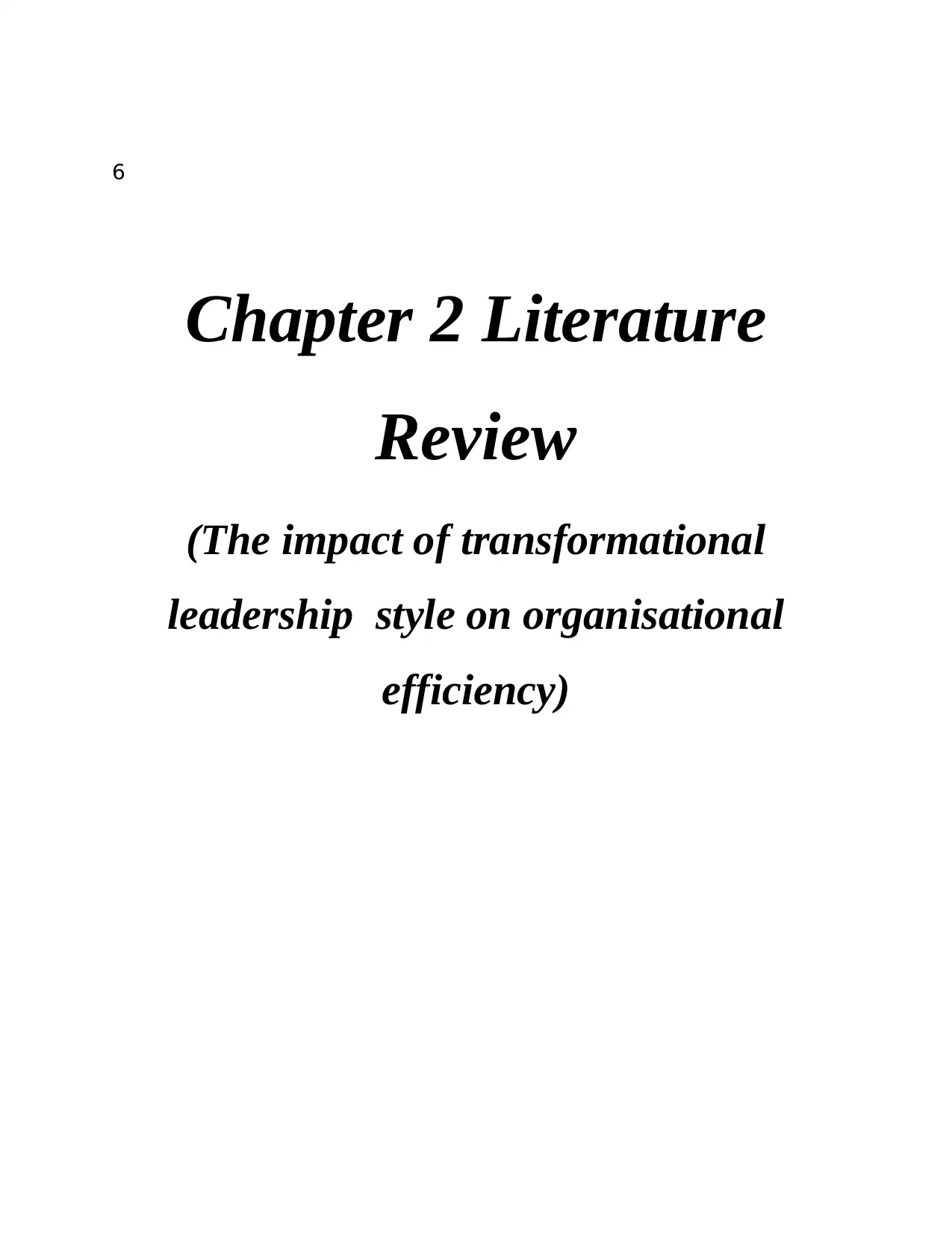
6
Chapter 2 Literature
Review
(The impact of transformational
leadership style on organisational
efficiency)
Chapter 2 Literature
Review
(The impact of transformational
leadership style on organisational
efficiency)
Paraphrase This Document
Need a fresh take? Get an instant paraphrase of this document with our AI Paraphraser

Contents
Contents...........................................................................................................................................2
INTRODUCTION...........................................................................................................................1
REFERENCES................................................................................................................................1
Contents...........................................................................................................................................2
INTRODUCTION...........................................................................................................................1
REFERENCES................................................................................................................................1
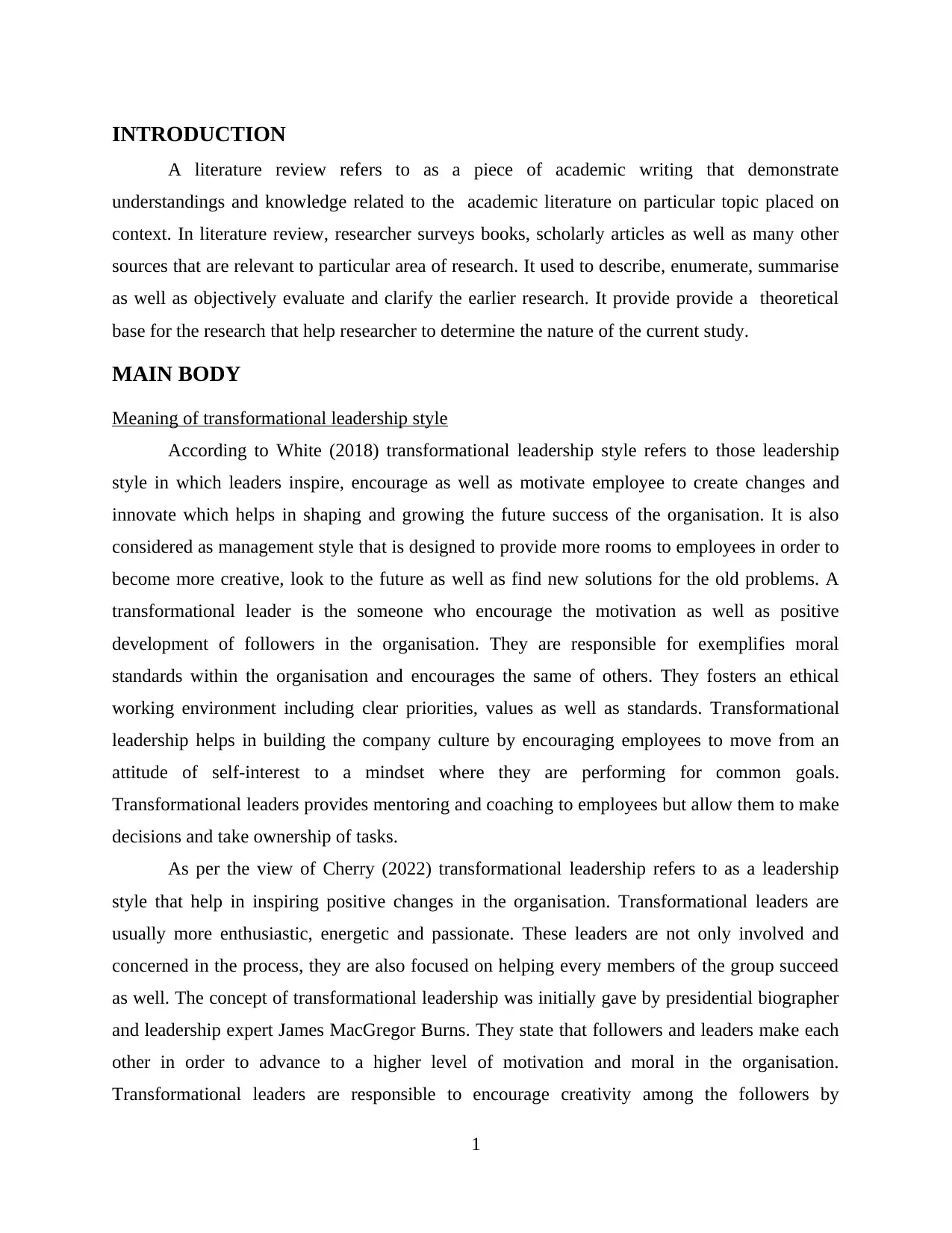
INTRODUCTION
A literature review refers to as a piece of academic writing that demonstrate
understandings and knowledge related to the academic literature on particular topic placed on
context. In literature review, researcher surveys books, scholarly articles as well as many other
sources that are relevant to particular area of research. It used to describe, enumerate, summarise
as well as objectively evaluate and clarify the earlier research. It provide provide a theoretical
base for the research that help researcher to determine the nature of the current study.
MAIN BODY
Meaning of transformational leadership style
According to White (2018) transformational leadership style refers to those leadership
style in which leaders inspire, encourage as well as motivate employee to create changes and
innovate which helps in shaping and growing the future success of the organisation. It is also
considered as management style that is designed to provide more rooms to employees in order to
become more creative, look to the future as well as find new solutions for the old problems. A
transformational leader is the someone who encourage the motivation as well as positive
development of followers in the organisation. They are responsible for exemplifies moral
standards within the organisation and encourages the same of others. They fosters an ethical
working environment including clear priorities, values as well as standards. Transformational
leadership helps in building the company culture by encouraging employees to move from an
attitude of self-interest to a mindset where they are performing for common goals.
Transformational leaders provides mentoring and coaching to employees but allow them to make
decisions and take ownership of tasks.
As per the view of Cherry (2022) transformational leadership refers to as a leadership
style that help in inspiring positive changes in the organisation. Transformational leaders are
usually more enthusiastic, energetic and passionate. These leaders are not only involved and
concerned in the process, they are also focused on helping every members of the group succeed
as well. The concept of transformational leadership was initially gave by presidential biographer
and leadership expert James MacGregor Burns. They state that followers and leaders make each
other in order to advance to a higher level of motivation and moral in the organisation.
Transformational leaders are responsible to encourage creativity among the followers by
1
A literature review refers to as a piece of academic writing that demonstrate
understandings and knowledge related to the academic literature on particular topic placed on
context. In literature review, researcher surveys books, scholarly articles as well as many other
sources that are relevant to particular area of research. It used to describe, enumerate, summarise
as well as objectively evaluate and clarify the earlier research. It provide provide a theoretical
base for the research that help researcher to determine the nature of the current study.
MAIN BODY
Meaning of transformational leadership style
According to White (2018) transformational leadership style refers to those leadership
style in which leaders inspire, encourage as well as motivate employee to create changes and
innovate which helps in shaping and growing the future success of the organisation. It is also
considered as management style that is designed to provide more rooms to employees in order to
become more creative, look to the future as well as find new solutions for the old problems. A
transformational leader is the someone who encourage the motivation as well as positive
development of followers in the organisation. They are responsible for exemplifies moral
standards within the organisation and encourages the same of others. They fosters an ethical
working environment including clear priorities, values as well as standards. Transformational
leadership helps in building the company culture by encouraging employees to move from an
attitude of self-interest to a mindset where they are performing for common goals.
Transformational leaders provides mentoring and coaching to employees but allow them to make
decisions and take ownership of tasks.
As per the view of Cherry (2022) transformational leadership refers to as a leadership
style that help in inspiring positive changes in the organisation. Transformational leaders are
usually more enthusiastic, energetic and passionate. These leaders are not only involved and
concerned in the process, they are also focused on helping every members of the group succeed
as well. The concept of transformational leadership was initially gave by presidential biographer
and leadership expert James MacGregor Burns. They state that followers and leaders make each
other in order to advance to a higher level of motivation and moral in the organisation.
Transformational leaders are responsible to encourage creativity among the followers by
1
⊘ This is a preview!⊘
Do you want full access?
Subscribe today to unlock all pages.

Trusted by 1+ million students worldwide
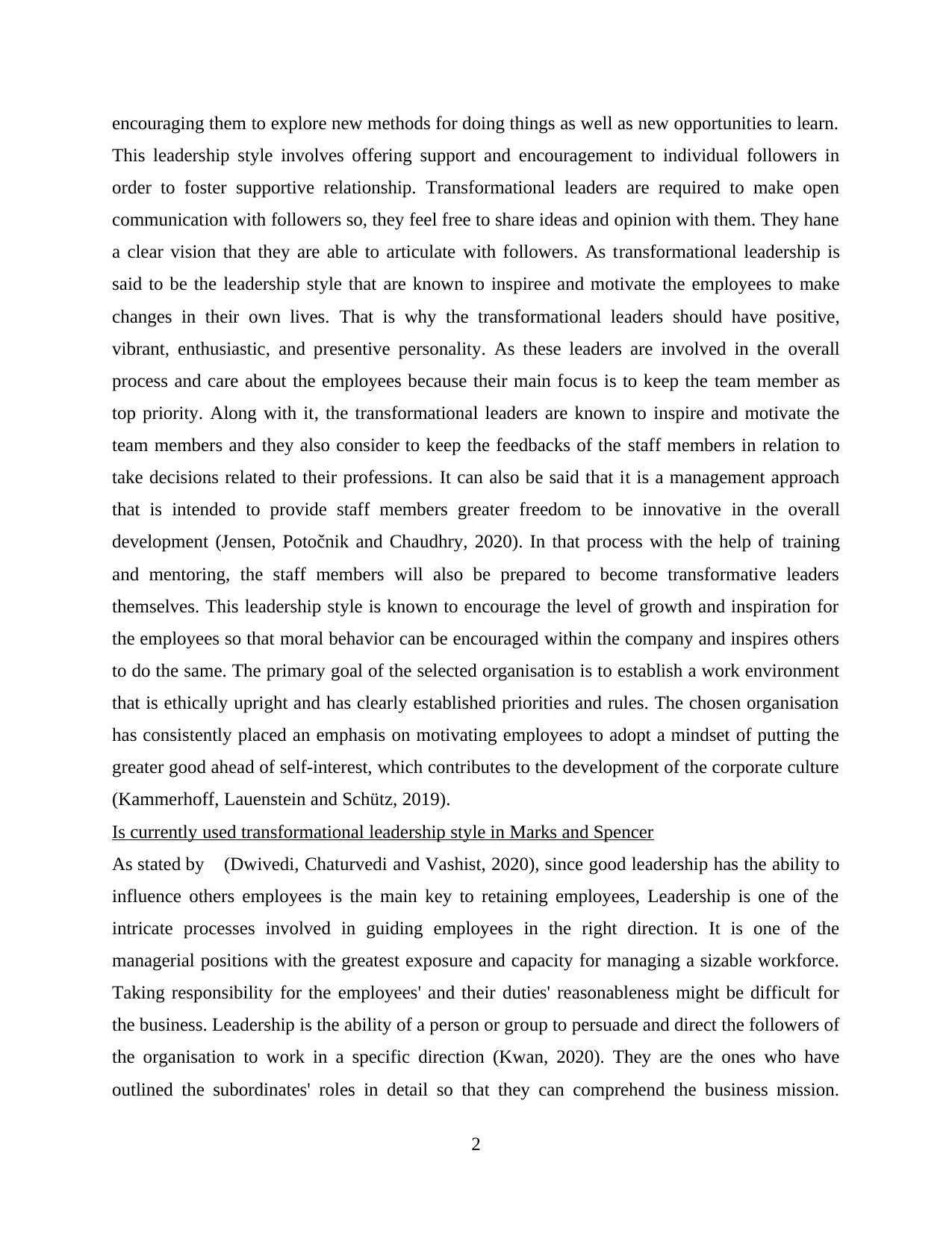
encouraging them to explore new methods for doing things as well as new opportunities to learn.
This leadership style involves offering support and encouragement to individual followers in
order to foster supportive relationship. Transformational leaders are required to make open
communication with followers so, they feel free to share ideas and opinion with them. They hane
a clear vision that they are able to articulate with followers. As transformational leadership is
said to be the leadership style that are known to inspiree and motivate the employees to make
changes in their own lives. That is why the transformational leaders should have positive,
vibrant, enthusiastic, and presentive personality. As these leaders are involved in the overall
process and care about the employees because their main focus is to keep the team member as
top priority. Along with it, the transformational leaders are known to inspire and motivate the
team members and they also consider to keep the feedbacks of the staff members in relation to
take decisions related to their professions. It can also be said that it is a management approach
that is intended to provide staff members greater freedom to be innovative in the overall
development (Jensen, Potočnik and Chaudhry, 2020). In that process with the help of training
and mentoring, the staff members will also be prepared to become transformative leaders
themselves. This leadership style is known to encourage the level of growth and inspiration for
the employees so that moral behavior can be encouraged within the company and inspires others
to do the same. The primary goal of the selected organisation is to establish a work environment
that is ethically upright and has clearly established priorities and rules. The chosen organisation
has consistently placed an emphasis on motivating employees to adopt a mindset of putting the
greater good ahead of self-interest, which contributes to the development of the corporate culture
(Kammerhoff, Lauenstein and Schütz, 2019).
Is currently used transformational leadership style in Marks and Spencer
As stated by (Dwivedi, Chaturvedi and Vashist, 2020), since good leadership has the ability to
influence others employees is the main key to retaining employees, Leadership is one of the
intricate processes involved in guiding employees in the right direction. It is one of the
managerial positions with the greatest exposure and capacity for managing a sizable workforce.
Taking responsibility for the employees' and their duties' reasonableness might be difficult for
the business. Leadership is the ability of a person or group to persuade and direct the followers of
the organisation to work in a specific direction (Kwan, 2020). They are the ones who have
outlined the subordinates' roles in detail so that they can comprehend the business mission.
2
This leadership style involves offering support and encouragement to individual followers in
order to foster supportive relationship. Transformational leaders are required to make open
communication with followers so, they feel free to share ideas and opinion with them. They hane
a clear vision that they are able to articulate with followers. As transformational leadership is
said to be the leadership style that are known to inspiree and motivate the employees to make
changes in their own lives. That is why the transformational leaders should have positive,
vibrant, enthusiastic, and presentive personality. As these leaders are involved in the overall
process and care about the employees because their main focus is to keep the team member as
top priority. Along with it, the transformational leaders are known to inspire and motivate the
team members and they also consider to keep the feedbacks of the staff members in relation to
take decisions related to their professions. It can also be said that it is a management approach
that is intended to provide staff members greater freedom to be innovative in the overall
development (Jensen, Potočnik and Chaudhry, 2020). In that process with the help of training
and mentoring, the staff members will also be prepared to become transformative leaders
themselves. This leadership style is known to encourage the level of growth and inspiration for
the employees so that moral behavior can be encouraged within the company and inspires others
to do the same. The primary goal of the selected organisation is to establish a work environment
that is ethically upright and has clearly established priorities and rules. The chosen organisation
has consistently placed an emphasis on motivating employees to adopt a mindset of putting the
greater good ahead of self-interest, which contributes to the development of the corporate culture
(Kammerhoff, Lauenstein and Schütz, 2019).
Is currently used transformational leadership style in Marks and Spencer
As stated by (Dwivedi, Chaturvedi and Vashist, 2020), since good leadership has the ability to
influence others employees is the main key to retaining employees, Leadership is one of the
intricate processes involved in guiding employees in the right direction. It is one of the
managerial positions with the greatest exposure and capacity for managing a sizable workforce.
Taking responsibility for the employees' and their duties' reasonableness might be difficult for
the business. Leadership is the ability of a person or group to persuade and direct the followers of
the organisation to work in a specific direction (Kwan, 2020). They are the ones who have
outlined the subordinates' roles in detail so that they can comprehend the business mission.
2
Paraphrase This Document
Need a fresh take? Get an instant paraphrase of this document with our AI Paraphraser
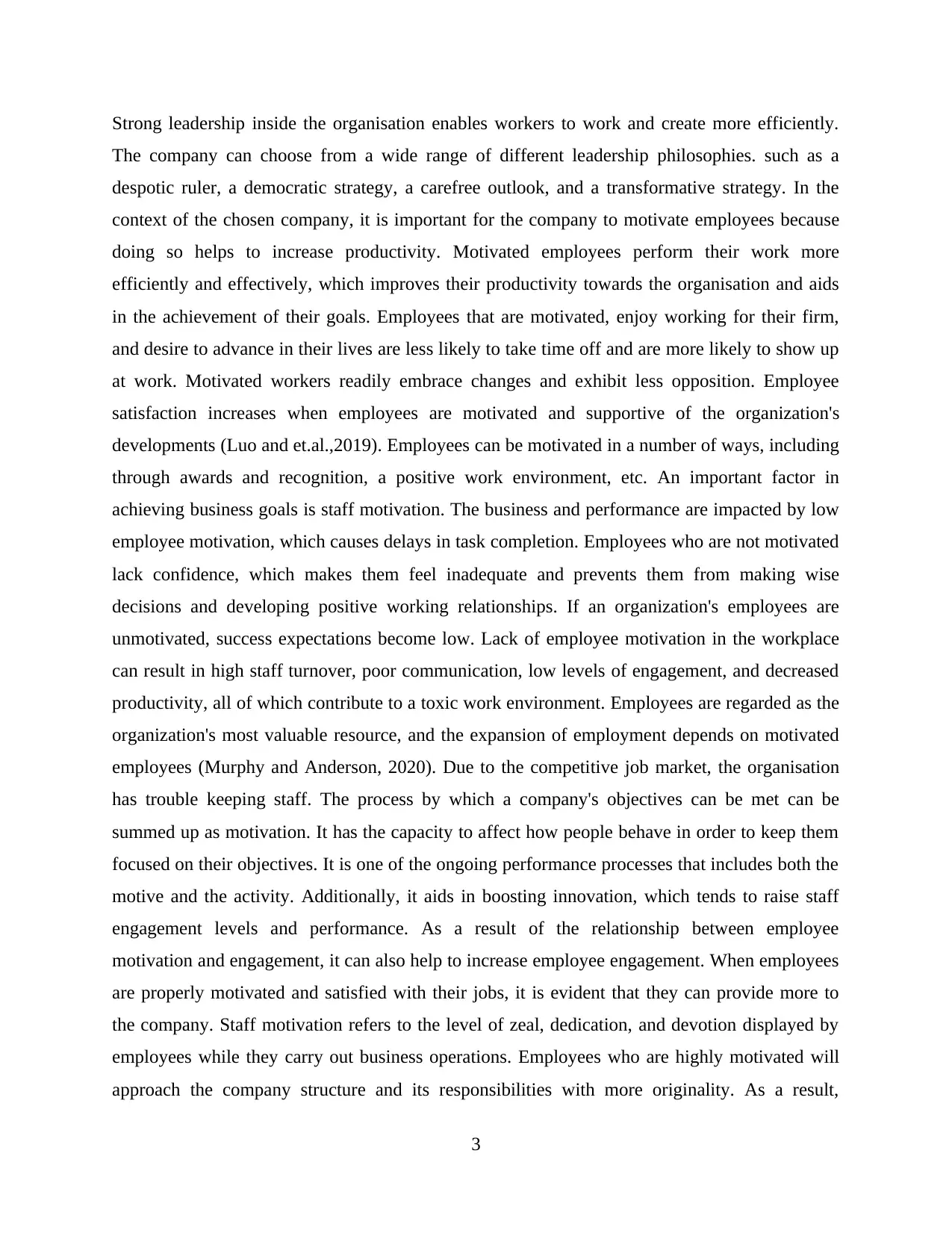
Strong leadership inside the organisation enables workers to work and create more efficiently.
The company can choose from a wide range of different leadership philosophies. such as a
despotic ruler, a democratic strategy, a carefree outlook, and a transformative strategy. In the
context of the chosen company, it is important for the company to motivate employees because
doing so helps to increase productivity. Motivated employees perform their work more
efficiently and effectively, which improves their productivity towards the organisation and aids
in the achievement of their goals. Employees that are motivated, enjoy working for their firm,
and desire to advance in their lives are less likely to take time off and are more likely to show up
at work. Motivated workers readily embrace changes and exhibit less opposition. Employee
satisfaction increases when employees are motivated and supportive of the organization's
developments (Luo and et.al.,2019). Employees can be motivated in a number of ways, including
through awards and recognition, a positive work environment, etc. An important factor in
achieving business goals is staff motivation. The business and performance are impacted by low
employee motivation, which causes delays in task completion. Employees who are not motivated
lack confidence, which makes them feel inadequate and prevents them from making wise
decisions and developing positive working relationships. If an organization's employees are
unmotivated, success expectations become low. Lack of employee motivation in the workplace
can result in high staff turnover, poor communication, low levels of engagement, and decreased
productivity, all of which contribute to a toxic work environment. Employees are regarded as the
organization's most valuable resource, and the expansion of employment depends on motivated
employees (Murphy and Anderson, 2020). Due to the competitive job market, the organisation
has trouble keeping staff. The process by which a company's objectives can be met can be
summed up as motivation. It has the capacity to affect how people behave in order to keep them
focused on their objectives. It is one of the ongoing performance processes that includes both the
motive and the activity. Additionally, it aids in boosting innovation, which tends to raise staff
engagement levels and performance. As a result of the relationship between employee
motivation and engagement, it can also help to increase employee engagement. When employees
are properly motivated and satisfied with their jobs, it is evident that they can provide more to
the company. Staff motivation refers to the level of zeal, dedication, and devotion displayed by
employees while they carry out business operations. Employees who are highly motivated will
approach the company structure and its responsibilities with more originality. As a result,
3
The company can choose from a wide range of different leadership philosophies. such as a
despotic ruler, a democratic strategy, a carefree outlook, and a transformative strategy. In the
context of the chosen company, it is important for the company to motivate employees because
doing so helps to increase productivity. Motivated employees perform their work more
efficiently and effectively, which improves their productivity towards the organisation and aids
in the achievement of their goals. Employees that are motivated, enjoy working for their firm,
and desire to advance in their lives are less likely to take time off and are more likely to show up
at work. Motivated workers readily embrace changes and exhibit less opposition. Employee
satisfaction increases when employees are motivated and supportive of the organization's
developments (Luo and et.al.,2019). Employees can be motivated in a number of ways, including
through awards and recognition, a positive work environment, etc. An important factor in
achieving business goals is staff motivation. The business and performance are impacted by low
employee motivation, which causes delays in task completion. Employees who are not motivated
lack confidence, which makes them feel inadequate and prevents them from making wise
decisions and developing positive working relationships. If an organization's employees are
unmotivated, success expectations become low. Lack of employee motivation in the workplace
can result in high staff turnover, poor communication, low levels of engagement, and decreased
productivity, all of which contribute to a toxic work environment. Employees are regarded as the
organization's most valuable resource, and the expansion of employment depends on motivated
employees (Murphy and Anderson, 2020). Due to the competitive job market, the organisation
has trouble keeping staff. The process by which a company's objectives can be met can be
summed up as motivation. It has the capacity to affect how people behave in order to keep them
focused on their objectives. It is one of the ongoing performance processes that includes both the
motive and the activity. Additionally, it aids in boosting innovation, which tends to raise staff
engagement levels and performance. As a result of the relationship between employee
motivation and engagement, it can also help to increase employee engagement. When employees
are properly motivated and satisfied with their jobs, it is evident that they can provide more to
the company. Staff motivation refers to the level of zeal, dedication, and devotion displayed by
employees while they carry out business operations. Employees who are highly motivated will
approach the company structure and its responsibilities with more originality. As a result,
3
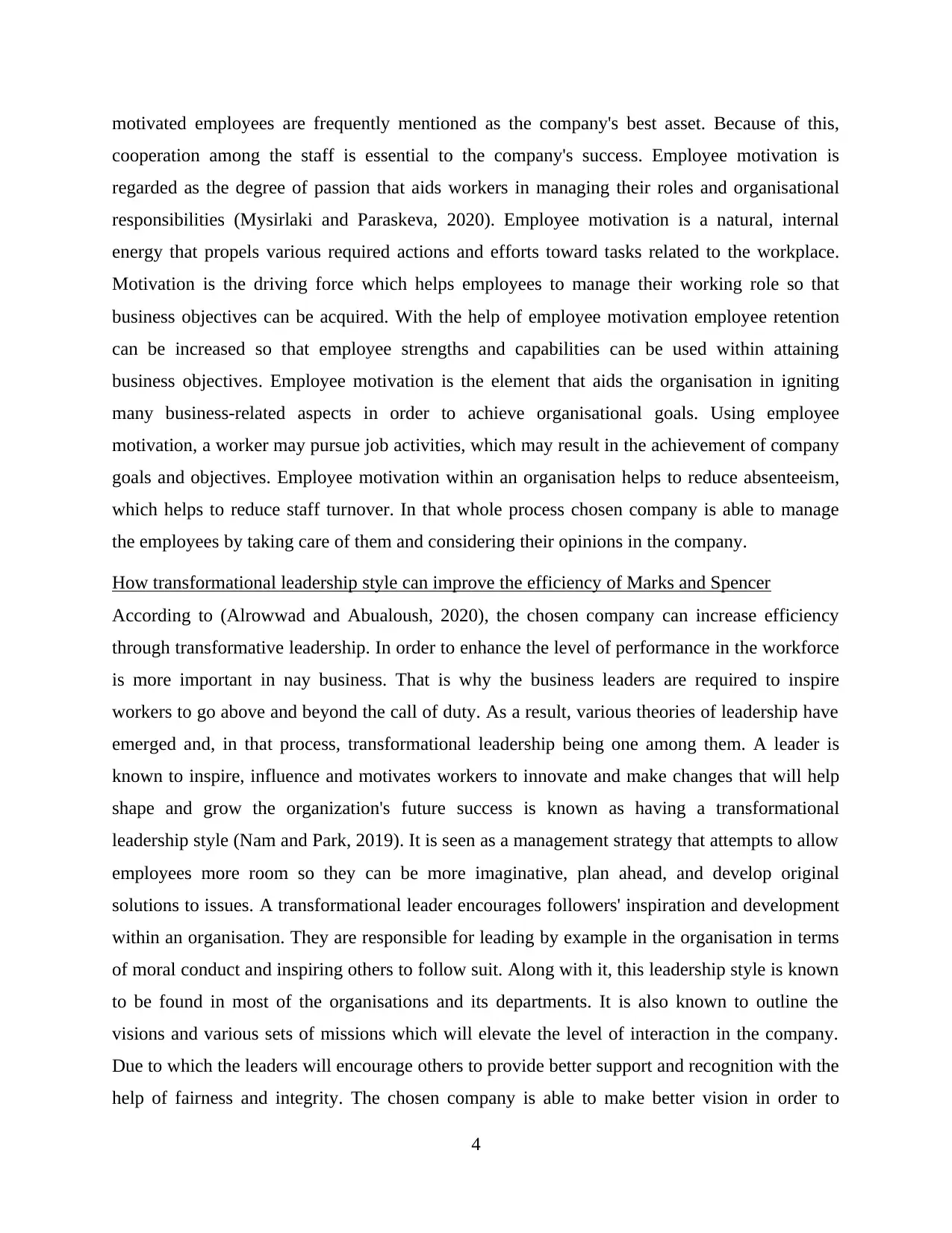
motivated employees are frequently mentioned as the company's best asset. Because of this,
cooperation among the staff is essential to the company's success. Employee motivation is
regarded as the degree of passion that aids workers in managing their roles and organisational
responsibilities (Mysirlaki and Paraskeva, 2020). Employee motivation is a natural, internal
energy that propels various required actions and efforts toward tasks related to the workplace.
Motivation is the driving force which helps employees to manage their working role so that
business objectives can be acquired. With the help of employee motivation employee retention
can be increased so that employee strengths and capabilities can be used within attaining
business objectives. Employee motivation is the element that aids the organisation in igniting
many business-related aspects in order to achieve organisational goals. Using employee
motivation, a worker may pursue job activities, which may result in the achievement of company
goals and objectives. Employee motivation within an organisation helps to reduce absenteeism,
which helps to reduce staff turnover. In that whole process chosen company is able to manage
the employees by taking care of them and considering their opinions in the company.
How transformational leadership style can improve the efficiency of Marks and Spencer
According to (Alrowwad and Abualoush, 2020), the chosen company can increase efficiency
through transformative leadership. In order to enhance the level of performance in the workforce
is more important in nay business. That is why the business leaders are required to inspire
workers to go above and beyond the call of duty. As a result, various theories of leadership have
emerged and, in that process, transformational leadership being one among them. A leader is
known to inspire, influence and motivates workers to innovate and make changes that will help
shape and grow the organization's future success is known as having a transformational
leadership style (Nam and Park, 2019). It is seen as a management strategy that attempts to allow
employees more room so they can be more imaginative, plan ahead, and develop original
solutions to issues. A transformational leader encourages followers' inspiration and development
within an organisation. They are responsible for leading by example in the organisation in terms
of moral conduct and inspiring others to follow suit. Along with it, this leadership style is known
to be found in most of the organisations and its departments. It is also known to outline the
visions and various sets of missions which will elevate the level of interaction in the company.
Due to which the leaders will encourage others to provide better support and recognition with the
help of fairness and integrity. The chosen company is able to make better vision in order to
4
cooperation among the staff is essential to the company's success. Employee motivation is
regarded as the degree of passion that aids workers in managing their roles and organisational
responsibilities (Mysirlaki and Paraskeva, 2020). Employee motivation is a natural, internal
energy that propels various required actions and efforts toward tasks related to the workplace.
Motivation is the driving force which helps employees to manage their working role so that
business objectives can be acquired. With the help of employee motivation employee retention
can be increased so that employee strengths and capabilities can be used within attaining
business objectives. Employee motivation is the element that aids the organisation in igniting
many business-related aspects in order to achieve organisational goals. Using employee
motivation, a worker may pursue job activities, which may result in the achievement of company
goals and objectives. Employee motivation within an organisation helps to reduce absenteeism,
which helps to reduce staff turnover. In that whole process chosen company is able to manage
the employees by taking care of them and considering their opinions in the company.
How transformational leadership style can improve the efficiency of Marks and Spencer
According to (Alrowwad and Abualoush, 2020), the chosen company can increase efficiency
through transformative leadership. In order to enhance the level of performance in the workforce
is more important in nay business. That is why the business leaders are required to inspire
workers to go above and beyond the call of duty. As a result, various theories of leadership have
emerged and, in that process, transformational leadership being one among them. A leader is
known to inspire, influence and motivates workers to innovate and make changes that will help
shape and grow the organization's future success is known as having a transformational
leadership style (Nam and Park, 2019). It is seen as a management strategy that attempts to allow
employees more room so they can be more imaginative, plan ahead, and develop original
solutions to issues. A transformational leader encourages followers' inspiration and development
within an organisation. They are responsible for leading by example in the organisation in terms
of moral conduct and inspiring others to follow suit. Along with it, this leadership style is known
to be found in most of the organisations and its departments. It is also known to outline the
visions and various sets of missions which will elevate the level of interaction in the company.
Due to which the leaders will encourage others to provide better support and recognition with the
help of fairness and integrity. The chosen company is able to make better vision in order to
4
⊘ This is a preview!⊘
Do you want full access?
Subscribe today to unlock all pages.

Trusted by 1+ million students worldwide
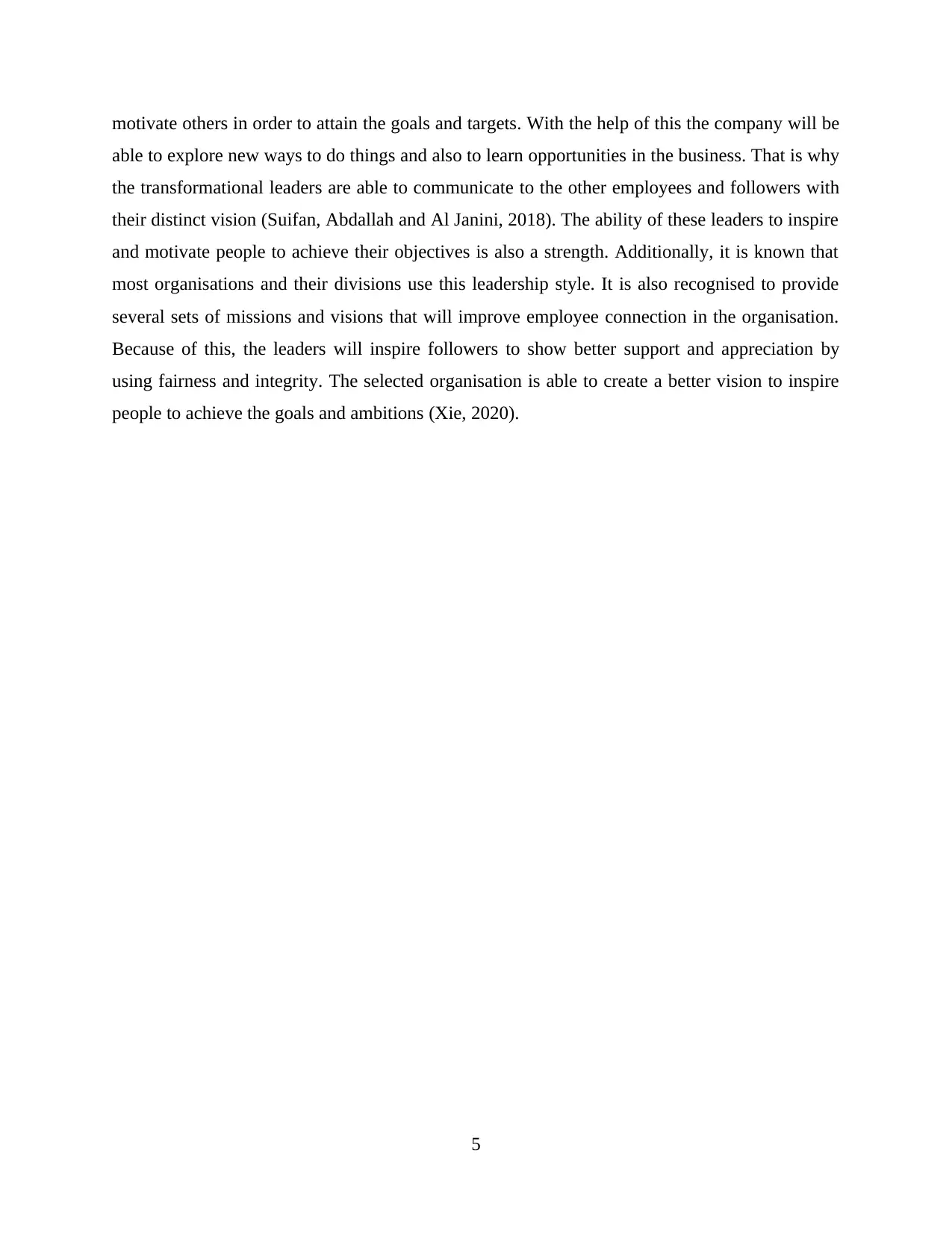
motivate others in order to attain the goals and targets. With the help of this the company will be
able to explore new ways to do things and also to learn opportunities in the business. That is why
the transformational leaders are able to communicate to the other employees and followers with
their distinct vision (Suifan, Abdallah and Al Janini, 2018). The ability of these leaders to inspire
and motivate people to achieve their objectives is also a strength. Additionally, it is known that
most organisations and their divisions use this leadership style. It is also recognised to provide
several sets of missions and visions that will improve employee connection in the organisation.
Because of this, the leaders will inspire followers to show better support and appreciation by
using fairness and integrity. The selected organisation is able to create a better vision to inspire
people to achieve the goals and ambitions (Xie, 2020).
5
able to explore new ways to do things and also to learn opportunities in the business. That is why
the transformational leaders are able to communicate to the other employees and followers with
their distinct vision (Suifan, Abdallah and Al Janini, 2018). The ability of these leaders to inspire
and motivate people to achieve their objectives is also a strength. Additionally, it is known that
most organisations and their divisions use this leadership style. It is also recognised to provide
several sets of missions and visions that will improve employee connection in the organisation.
Because of this, the leaders will inspire followers to show better support and appreciation by
using fairness and integrity. The selected organisation is able to create a better vision to inspire
people to achieve the goals and ambitions (Xie, 2020).
5
Paraphrase This Document
Need a fresh take? Get an instant paraphrase of this document with our AI Paraphraser
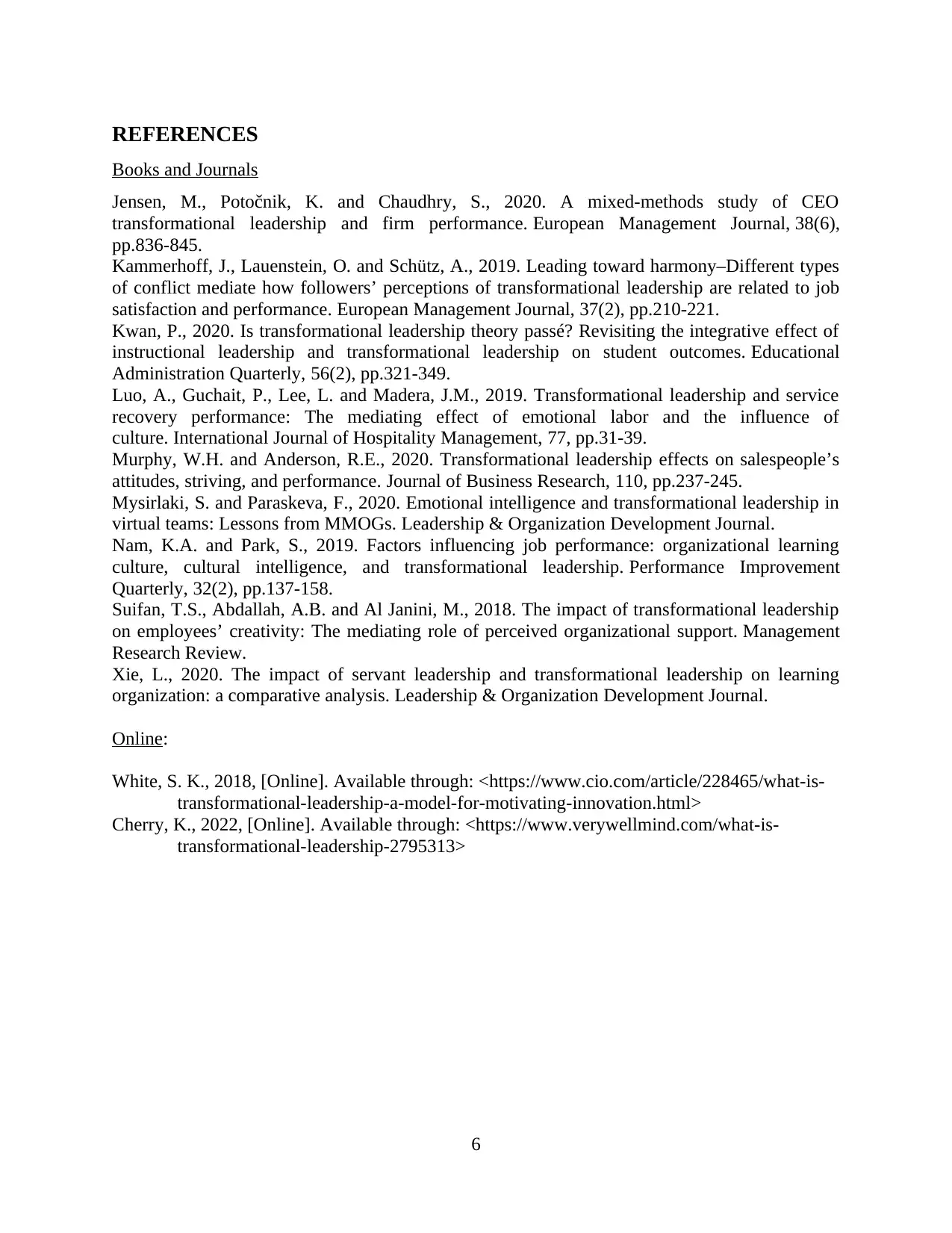
REFERENCES
Books and Journals
Jensen, M., Potočnik, K. and Chaudhry, S., 2020. A mixed-methods study of CEO
transformational leadership and firm performance. European Management Journal, 38(6),
pp.836-845.
Kammerhoff, J., Lauenstein, O. and Schütz, A., 2019. Leading toward harmony–Different types
of conflict mediate how followers’ perceptions of transformational leadership are related to job
satisfaction and performance. European Management Journal, 37(2), pp.210-221.
Kwan, P., 2020. Is transformational leadership theory passé? Revisiting the integrative effect of
instructional leadership and transformational leadership on student outcomes. Educational
Administration Quarterly, 56(2), pp.321-349.
Luo, A., Guchait, P., Lee, L. and Madera, J.M., 2019. Transformational leadership and service
recovery performance: The mediating effect of emotional labor and the influence of
culture. International Journal of Hospitality Management, 77, pp.31-39.
Murphy, W.H. and Anderson, R.E., 2020. Transformational leadership effects on salespeople’s
attitudes, striving, and performance. Journal of Business Research, 110, pp.237-245.
Mysirlaki, S. and Paraskeva, F., 2020. Emotional intelligence and transformational leadership in
virtual teams: Lessons from MMOGs. Leadership & Organization Development Journal.
Nam, K.A. and Park, S., 2019. Factors influencing job performance: organizational learning
culture, cultural intelligence, and transformational leadership. Performance Improvement
Quarterly, 32(2), pp.137-158.
Suifan, T.S., Abdallah, A.B. and Al Janini, M., 2018. The impact of transformational leadership
on employees’ creativity: The mediating role of perceived organizational support. Management
Research Review.
Xie, L., 2020. The impact of servant leadership and transformational leadership on learning
organization: a comparative analysis. Leadership & Organization Development Journal.
Online:
White, S. K., 2018, [Online]. Available through: <https://www.cio.com/article/228465/what-is-
transformational-leadership-a-model-for-motivating-innovation.html>
Cherry, K., 2022, [Online]. Available through: <https://www.verywellmind.com/what-is-
transformational-leadership-2795313>
6
Books and Journals
Jensen, M., Potočnik, K. and Chaudhry, S., 2020. A mixed-methods study of CEO
transformational leadership and firm performance. European Management Journal, 38(6),
pp.836-845.
Kammerhoff, J., Lauenstein, O. and Schütz, A., 2019. Leading toward harmony–Different types
of conflict mediate how followers’ perceptions of transformational leadership are related to job
satisfaction and performance. European Management Journal, 37(2), pp.210-221.
Kwan, P., 2020. Is transformational leadership theory passé? Revisiting the integrative effect of
instructional leadership and transformational leadership on student outcomes. Educational
Administration Quarterly, 56(2), pp.321-349.
Luo, A., Guchait, P., Lee, L. and Madera, J.M., 2019. Transformational leadership and service
recovery performance: The mediating effect of emotional labor and the influence of
culture. International Journal of Hospitality Management, 77, pp.31-39.
Murphy, W.H. and Anderson, R.E., 2020. Transformational leadership effects on salespeople’s
attitudes, striving, and performance. Journal of Business Research, 110, pp.237-245.
Mysirlaki, S. and Paraskeva, F., 2020. Emotional intelligence and transformational leadership in
virtual teams: Lessons from MMOGs. Leadership & Organization Development Journal.
Nam, K.A. and Park, S., 2019. Factors influencing job performance: organizational learning
culture, cultural intelligence, and transformational leadership. Performance Improvement
Quarterly, 32(2), pp.137-158.
Suifan, T.S., Abdallah, A.B. and Al Janini, M., 2018. The impact of transformational leadership
on employees’ creativity: The mediating role of perceived organizational support. Management
Research Review.
Xie, L., 2020. The impact of servant leadership and transformational leadership on learning
organization: a comparative analysis. Leadership & Organization Development Journal.
Online:
White, S. K., 2018, [Online]. Available through: <https://www.cio.com/article/228465/what-is-
transformational-leadership-a-model-for-motivating-innovation.html>
Cherry, K., 2022, [Online]. Available through: <https://www.verywellmind.com/what-is-
transformational-leadership-2795313>
6
1 out of 8
Related Documents
Your All-in-One AI-Powered Toolkit for Academic Success.
+13062052269
info@desklib.com
Available 24*7 on WhatsApp / Email
![[object Object]](/_next/static/media/star-bottom.7253800d.svg)
Unlock your academic potential
Copyright © 2020–2025 A2Z Services. All Rights Reserved. Developed and managed by ZUCOL.




